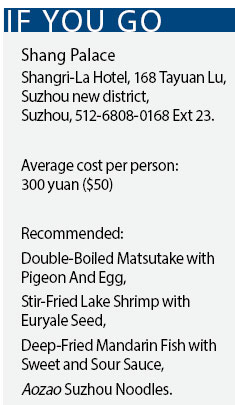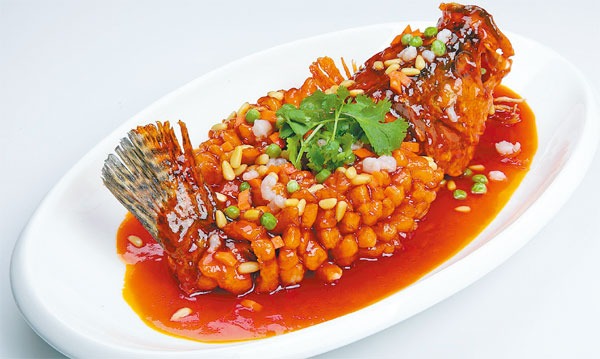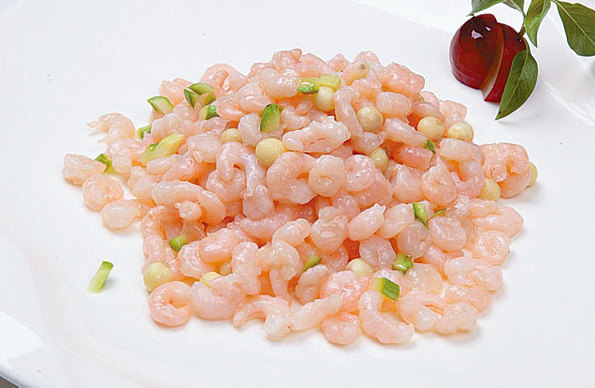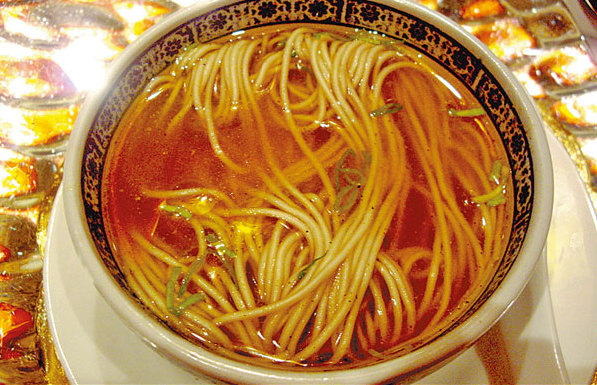Right royal elegance
Updated: 2013-11-17 07:14
By Rebecca Lo(China Daily)
|
|||||||
Even the emperors of the past often escaped their palaces to enjoy the attractions of Suzhou food and scenery. Rebecca Lo does the same.
Jiangsu province is dotted with picturesque rivers and lakes that give rise to the dominance of freshwater fish and seafood in its cuisine. And food is something that the residents of Suzhou take very seriously.
A city that takes pride in every aspect of its rich cultural heritage, Suzhou's natives believe that it is important to eat locally sourced, seasonally appropriate food to promote health and equilibrium.
While many Shang Palaces around Asia tend to specialize in traditional Cantonese dishes, Shang Palace at the Shangri-La Hotel in Suzhou does things differently.
|
Shang Palace at the Shangri-La Hotel in Suzhou offers local dishes, including the famous Mandarin fish. Photos provided to China Daily |
|
When in Suzhou, it is de rigueur to try the region's lake shrimp. |
|
Aozao noodles features a springy texture complemented by five-spice broth. |
Its unique situation between the historic city and the high-tech Suzhou Industrial Park means that the hotel attracts both locals and expats in town for business. For the latter, it makes sense to try local dishes that aren't available elsewhere. This is reflected in the menu, with dishes elevated to a refined level of sophistication that cements the fine dining establishment's reputation.
On a recent visit to Suzhou, we decided to indulge in as many local dishes as we could fit into our tummies. Though we noticed a few Cantonese staples on the menu, we were drawn to the many Huaiyang dishes that showcased produce from the fall season.
We started with Suzhou-style fried fish artfully presented against a floral motif finely rendered in colored sugar. The freshwater fish was cut into chunks and deep-fried before it was smothered in a sweet sauce that still allowed fishy goodness to shine through. I loved its firm texture, kept intact by the frying method.
Next, we enjoyed sauteed broad bean with scallion. I am not partial to legumes, but this dish was seriously addictive. It was served cold, and the smattering of scallions added a nice tang to the simple oil-based sauce the beans floated within.

When in Suzhou, it is de rigueur to try the region's lake shrimp. We had the tiny crustaceans stir-fried with Euryale seed and celery, and it was the culinary equivalent of diving into a freshwater lake. The shrimp were sweet and firm, cooked just enough to take the rawness out of them while keeping all of their natural flavors intact.
Double-boiled matsutake with pigeon and egg was easily my favorite part of the meal. I don't often get a chance to indulge in hearty and nourishing double-boiled soups, and the rich broth was warming and intense with robust mushroom flavor.
Naturally, we had to try their version of Suzhou's famous Mandarin fish. It was presented on an oval plate elevated above tea lights to keep the sweet and sour sauce piping hot. A garnish of cilantro gave the crunchy fish additional freshness, while the pine nuts and peas rounded out its hard and soft textures.
Our vegetable dish featured eight seasonal aquatic plants, simply prepared by stir-frying in light oil. The crunchy textures and contrasting colors of yellow, orange, green, white and black were delicious and a wonderful way to savor vegetables at their peak.
We finished with Chinese date rice cakes, a specialty of Suzhou, and aozao noodles. Dates and I are not the best of friends, and I found the cakes a bit on the dry side. But I couldn't get enough of the noodles, which reminded me of the best dandan noodles. The springy texture was perfectly complemented by the five-spice broth worthy of slurping to the last drop.
(China Daily 11/17/2013 page14)


